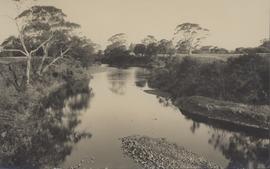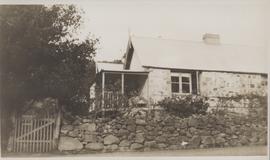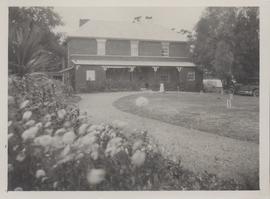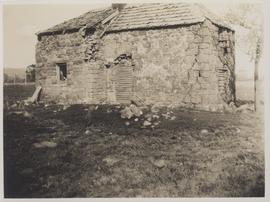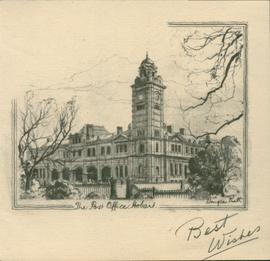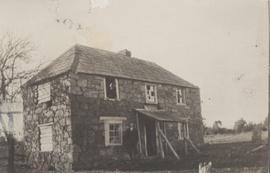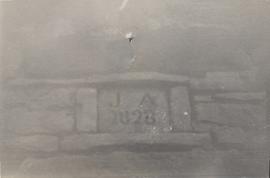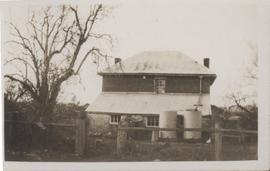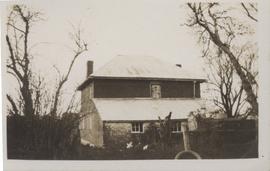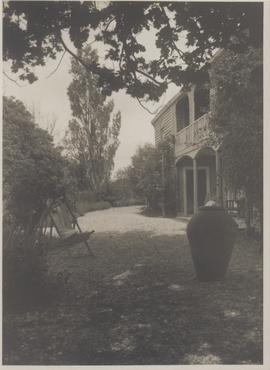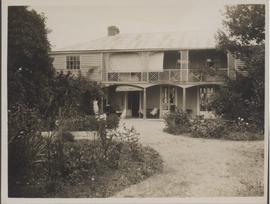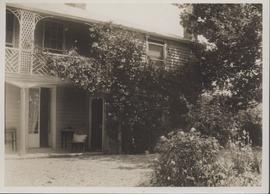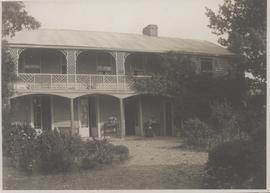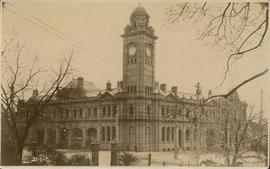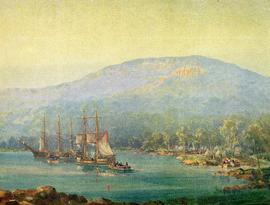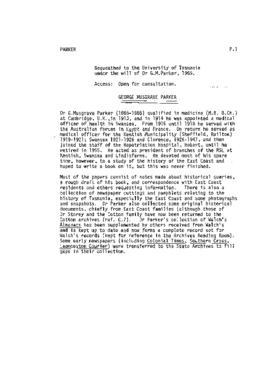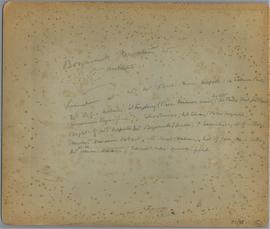Some records of Great Swanport and the Municipality of Glamorgan 1820-1920 by G. Musgrave Parker' c.1950 . Typed draft, corrected ms., with ms notes and illustrations (snapshots or newspaper cuttings) in 16 chapters and 3 appendices. The draft is in an unfinished state; many gaps have been left for dates or other information to be added, and numerous ms. notes, clippings, etc. have been inserted or left loose in the folders.
Chapter 1 -Early history 1642-1821
Chapter 2 The pioneers 1821-1826
Chapter 3 Under military control 1826-1840
Chapter 4 The native problem in Great Swanport.
Chapter 5 Bushrangers in the district.
Chapter 6 Whaling sealing and some early exports.
Chapter 7 Civilian administration 1841-1859
Chapter 8 The Rural Municipal Council 1860-1920 (police, medical men, coroners, Registrar of Births, Deaths, Marriages).
Chapter 9 Sheep and wool, wattle bark and agriculture
Chapter 10 Coal, tin, gold and lime.
Chapter 11 Roads, bridges, jetties.
Chapter 12 Shipping on the coast.
Chapter 13 The story of the churches
Chapter 14 Parliament and the local representatives
Chapter 15 Education, postal history, societies & clubs.
Chapter 16 Growth of district and township, notable visitors, wars, other notable events and weather.
Appendix A Grants and location orders [Land].
Appendix B Local persons of note (brief biographical notes in alphabetical order)
Appendix C Diary of Adam Amos 1822-1825.
Illustrations included:
Ch. 1. J.A. Graham, first Warden 1860
Ch 2. Pompey's Pillar, Alexandria, Creek Hut (G. Meredith's first residence), Cambria, Cranbrook House, Glen Gala
Ch 3. Red Banks ~ 1890 and later, Apsley, Apslawn, Milton (J. Allen's residence), Swanwick, 'The White Hut' Little Swanport, Kebreden, Kelvedon Rocky Hills Station (including stereoscopic photos of the ruins of the tread mill and lime kiln.
Ch 4. Aborigines, Muirlands Little Swanport (residence of John Radford) , Waubadebar’s grave Bicheno.
Ch 6. Wineglass Bay, Trumpeter Bay, Schouten Island, Meredith's Fishery, a trypot.
Ch 7. Waterloo Point 1852 (watercolour sketch on grey card copied from original at Cambria by Mary Ann Walker 1928
Ch 8. Wardens (J.A. Graham, F. Shaw, Carmichael Lyne, F.C. Shaw, W.F.G. Calvert (news clippings), Council Chambers, Alfred W. Smith, Robert Gould, F. Lyne, G.F. Storey (Beattie's Studio), Dr. E.W. Pilgrim, Dr. E.C. McCarthy, Dr. G.S. Rundle (c. 1860-70)
Ch 9. Sheep, wool press, Picnic Place from Apsley, Mayfield Mill and outhouses (late 19th cent.), Oyster Bay pine.
Ch 10. Bicheno
Ch 11. Rocky Hills culvert, Spiky Bridge Swansea, Swansea jetty.
Ch 12. Cutter 'Thames', ketches 'Good Intent' - 'Foam'.
Ch 13. All Saints Church, Swansea, Bernard Shaw, Shaw memorial window, Bishops Nixon, Bromby, Sandford, Montgomery, Mercer (news clippings), Frank Morris Gill, Tomb of Rev. Thomas Dove Swansea, Swansea (including Catholic Church), Gala Kirk, Fr. Thomas Kelsh (news clipping).
Ch 14. E.T. Miles, John Lyne, F. Lyne, W.H. Bennett, James White, H. Lamb, W.W. Perkins, J. Murdoch, James Lord, J. Mitchell, J. Meredith, C. Meredith, W.J. McWilliams, A. Hearn.
Ch 16. Swansea views Appendix B Graveyard at Llandaff.

